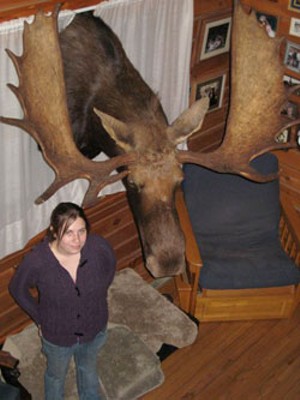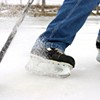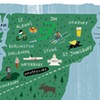Published March 11, 2009 at 6:16 a.m.
Five and a half years ago, a few days before Halloween, Casey Hamwey and her uncle Roger Blake saw a moose on a mountain in the Northeast Kingdom. The animal kicked dirt. Hamwey fired her rifle and watched the moose fall. Then she called her aunt Susan Blake, who was stationed at a nearby hunting camp.
Hamwey’s aunt didn’t believe her niece’s description of the half-ton carcass. The 14-year-old hunter, for her part, didn’t imagine she had, as a front-page newspaper caption would claim, “reached a goal many hunters wait a lifetime for.” And she didn’t know her moose’s 63-inch antler rack would be the eighth largest ever reported in Vermont.
In past decades, Hamwey’s “big-game trophy” might have been archived by officials from the Vermont Fish and Wildlife Department. But eight years ago, a funding crunch forced the department’s big-game archive, established in 1983, into premature retirement. Hamwey didn’t receive formal recognition from a Vermont scorer until this year, when she saw a TV ad for the Vermont Big Game Trophy Club. After Hamwey called the nonprofit’s co-founder, Curtis Smiley, he came by with measurement gear.
Since last spring, with help from taxidermists and volunteers, Fish and Wildlife employee Smiley and fellow hunting aficionado Brad Hanson have been measuring whitetail deer, black bear, turkey and moose killed in Vermont since 2001, as well as trophies shot between 1909 and 1983 that were never recorded. Fish and Wildlife has deemed them “official keepers” of state trophy records. Now they’re scouring the state for taxidermy treasures.
The Fairfax-based Vermont Big Game Trophy Club is more public resource than cult secret. Smiley and Hanson are posting records in Outdoors magazine and on their website, Vermontbiggametrophyclub.com, which includes links to archival photographs. They plan to publish a related book of big-game stories, photographs and trophy listings in 2010.
Creating a big-game records archive requires time, gasoline — and money. Smiley says the nonprofit has raised $7000 since last April. A senior game warden who has worked for Fish and Wildlife since 1994, he tours the state in his spare time scouting unrecorded trophies and remeasuring existing ones. Last summer, he scored 90-year-old animals at the Beach Lodge, a mock hunting camp at the Shelburne Museum. Smiley sees the trophy club as reviving the state’s big-game reputation, which he claims has deteriorated in the last decade.
That’s a subjective assessment. But the numbers do show Vermont’s average big-game trophy isn’t as big as it used to be, says Mark Scott of the Fish and Wildlife Department. Scott, who started the state’s big-game record program, explains that huntable animals grow in proportion to the pasture lands they can access. Since Vermont’s forests rebounded in the 20th century, he says, the state has become less attractive to big-game hunters than are such grassier destinations as Pennsylvania and Michigan.
It’s not that Scott thinks Vermont is a bad place to hunt. The state’s deer herd is larger than it was 15 years ago and denser per square mile than that of any other New England state, he notes. Fish and Wildlife Commissioner Wayne Laroche is currently trying to increase the state’s stock of mature deer via stricter antler restrictions.
Local interest in hunting appears to be holding steady. Despite a 14 percent overall drop in license sales since 2001, Vermont’s hunter-license registry increased slightly between 2005 and 2007, from 80,476 to 83,089. Scott says the Vermont Big Game Trophy Club won’t directly increase license sales. But to his mind, “Any time people generate excitement about an activity, it’s going to lead to more participation.”
Attracting new hunters is hard in a digital age, notes Curtis Smiley. He remembers hunting as a kid growing up in Westford — “I hate to say it, but it’s Chittenden County” — and thinks today’s young Vermonters don’t spend enough time outside. To help build buzz around their archiving project, Smiley and Hanson have revived an annual awards banquet Fish and Wildlife discontinued in 2001. They’re also buying advertisements and attending public events such as the Yankee Sportsman’s Classic, an annual hunter’s bazaar at the Champlain Valley Expo in Essex Junction.
Passing the beef jerky and camouflage vendors at the January event, Expo attendees couldn’t miss the full-wall Vermont Big Game Trophy Club display. A gaggle of volunteers stood at card tables wearing matching sleeveless shirts. Behind them, Casey Hamwey’s moose head and dozens of dead deer and moose faces stared plaintively from their mounts. A stuffed bear cub lay curled on the floor.
Two days into the event, Smiley was shooting the breeze with Expo patrons. Some, like Casey Hamwey’s aunt, weren’t shocked by the size of his big-game display. Others approached it as if they were kids in a petting zoo.
“What do you think?” Smiley asked one incredulous visitor.
“You just don’t see ’em like that,” the man replied.
“It’s depends what you’re used to,” Smiley said.
“I can’t believe they were shot in Vermont.”
“Could be because they weren’t displayed, you weren’t aware.”
A few Saturdays after the Yankee Sportsman’s Classic, Vermont’s big-game mounts are back home with their respective owners. Casey Hamwey’s trophy stares down from a wood-paneled wall at the Blakes’ South Royalton home, dwarfing the smaller elk and caribou noggins the family has acquired in big-game destinations like Montana and northern Canada. The scene evokes a crowded antique shop out west.
Hamwey, a soft-spoken 19-year-old with dark brown hair and a warm smile, drinks tea at the kitchen table with her aunt and uncle. She says she’s thinking of hunting moose this fall if she can find time between her classes at Lyndon State College and a part-time job. But her aunt and uncle can’t stop gushing about her now-famous kill.
Back in the Kingdom that fateful October day, Susan Blake recalls, they had to borrow a logging machine to transport Hamwey’s moose down from the mountain. Later that day, when she and Roger dropped their niece off at a Halloween ball, droves of inquisitive dancers crowded around their truck.
“She emptied the gymnasium,” Roger says with a laugh, noting that the school’s principal was impressed by Hamwey’s feat. “You could spend $10,000 in the Yukon and not get a moose that big.”
“Most of the kids were in awe,” Susan affirms, “— especially the boys.”
2009 Animal Issue
This story was part of our 2009 Animal Issue. Click here for more animal stories.
More By This Author
Speaking of Animals
-

Q&A: A Clinic Has Cared for Old North End Pets for Almost 20 Years
Jan 31, 2024 -

Video: The Old North End Veterinary Clinic Has Kept Costs Low to Help Pets in Burlington for Almost 20 Years
Jan 25, 2024 -

Q&A: Merrymac Farm Sanctuary in Charlotte Provides a Forever Home for Neglected Animals
Dec 6, 2023 -

Video: Neglected Animals Find a Home With Era MacDonald at Merrymac Farm Sanctuary in Charlotte
Nov 30, 2023 -

Response Teams Provide Shelter for Pets of Evacuated Vermonters
Jul 16, 2023 - More »
Comments
Comments are closed.
From 2014-2020, Seven Days allowed readers to comment on all stories posted on our website. While we've appreciated the suggestions and insights, right now Seven Days is prioritizing our core mission — producing high-quality, responsible local journalism — over moderating online debates between readers.
To criticize, correct or praise our reporting, please send us a letter to the editor or send us a tip. We’ll check it out and report the results.
Online comments may return when we have better tech tools for managing them. Thanks for reading.













































